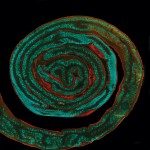Link to Pubmed [PMID] – 22531912
Eur. J. Immunol. 2012 Apr;42(4):851-62
HFE, an MHC class Ib molecule that controls iron metabolism, can be directly targeted by cytotoxic TCR αβ T lymphocytes. Transgenic DBA/2 mice expressing, in a Rag 2 KO context, an αβ TCR that directly recognizes mouse HFE (mHFE) were created to further explore the interface of HFE with the immune system. TCR-transgenic mHfe WT mice deleted mHFE-reactive T cells in the thymus, but a fraction of reprogrammed cells were able to escape deletion. In contrast, TCR-transgenic mice deprived of mHFE molecules (mHfe KO mice) or expressing a C282→Y mutated mHFE molecule – the most frequent mutation associated with human hereditary hemochromatosis – positively selected mHFE-reactive CD8(+) T lymphocytes and were not tolerant toward mHFE. By engrafting these mice with DBA/2 WT (mHFE(+)) skin, it was established, as suspected on the basis of similar engraftments performed on DBA/2 mHfe KO mice, that mHFE behaves as an autonomous skin-associated histocompatibility antigen, even for mHFE-C282→Y mutated mice. By contrast, infusion of DBA/2 mHFE(+) mice with naïve mHFE-reactive transgenic CD8(+) T lymphocytes did not induce GVHD. Thus, tolerance toward HFE in mHfe WT mice can be acquired at either thymic or peripheral levels but is disrupted in mice reproducing human familial hemochromatosis.



